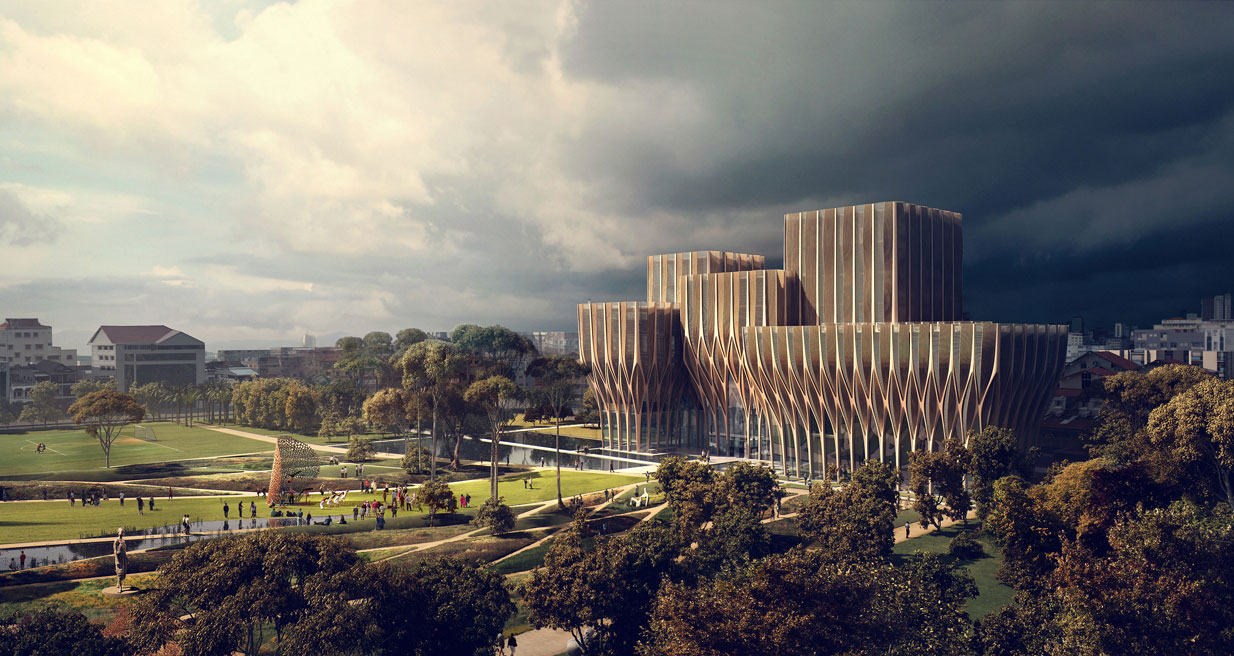វៀតណាមប្រកាសសង់ស្ដូបមិត្ដភាពកម្ពុជា-វៀតណាមនៅប្រទេសរបស់ខ្លួន ដើម្បីបង្ហាញពីមិត្តភាពដ៏រឹងមាំ និងស្អិតល្មួត
វៀតណាម បានបង្ហាញនូវគម្រោងសាងសង់ស្ដូបមិត្ដភាពកម្ពុជា-វៀតណាមនៅក្នុងប្រទេសរបស់ខ្លួន ដើម្បីបង្ហាញពីការដឹងគុណទៅវិញទៅមក និងដើម្បីបង្ហាញដល់សាធារណៈមតិជាតិ និងអន្ដរជាតិឱ្យដឹងកាន់តែច្បាស់អំពីទំនាក់ទំនងដ៏រឹងមាំ និងស្អិតល្មួតរវាងកម្ពុជា-វៀតណាមនៅគ្រប់កាលៈទេសៈ។ ការបង្ហាញពីគម្រោងសាងសង់ស្ដូបមិត្ដភាពកម្ពុជា-វៀតណាមនេះ បានធ្វើឡើងក្នុងឱកាសដែលសម្ដេចអគ្គមហាសេនាបតីតេជោ ហ៊ុន សែន ប្រធានព្រឹទ្ធសភានៃព្រះរាជាណាចក្រកម្ពុជា អនុញ្ញាតឱ្យ នាយឧត្ដមសេនីយ៍ ហ្វៀន តិន គឿង (Nguyen Tan Cuong) អនុរដ្ឋមន្ត្រីក្រសួងការពារប្រទេសវៀតណាមអគ្គសេនាធិការកងទ័ពប្រជាជនវៀតណាម ចូលជួបសម្ដែងការគួរសម នៅវិមាន៧មករា នៅថ្ងៃទី៤ ខែមិថុនា ឆ្នាំ២០២៥នេះ។ ថ្លែងប្រាប់អ្នកសារព័ត៌មានក្រោយបញ្ចប់ជំនួបខាងលើ ឯកឧត្ដម ជា ធារិទ្ធ អ្នកនាំពាក្យព្រឹទ្ធសភាបានបញ្ជាក់ថា អនុរដ្ឋមន្ត្រីក្រសួងការពារប្រទេសវៀតណាម បានរំលេចអំពីគម្រោងសាងសង់ស្ដូបមិត្ដភាពកម្ពុជា-វៀតណាមនៅក្នុងសារមន្ទីរមួយនៅប្រទេសវៀតណាម ដើម្បីចង់បង្ហាញទៅដល់សាធារណៈមតិជាតិ និងអន្ដរជាតិឱ្យកាន់តែយល់ច្បាស់ និងស៊ីជម្រៅអំពីទំនាក់ទំនងដ៏ស្អិតរមួតរវាងកម្ពុជា-វៀតណាមនៅគ្រប់កាលៈទេសៈ។ ជាពិសេស ក្នុងវិស័យកងទ័ពរវាងប្រទេសទាំងពីរ ដែលបានងើបរួមគ្នាតវ៉ា និងរើសបម្រាស់ខ្លួនចេញពីអាណានិគមន៍នាពេលកន្លងមក។ ឯកឧត្ដម បានបន្តថា សម្តេចតេជោបានឆ្លើយតបដោយសម្ដែងនូវការពេញចិត្ដចំពោះគម្រោងសាងសង់ស្ដូបមិត្ដភាពកម្ពុជា-វៀតណាមនៅប្រទសវៀតណាមនេះ បន្ទាប់ពីកម្ពុជាបានកសាងស្ដូបមិត្ដភាពកម្ពុជា-វៀតណាមនៅក្នុងប្រទេសរបស់ខ្លួនរួចហើយ។ ឯកឧត្ដម បានលើកឡើងនូវប្រសាសន៍សម្តេចតេជោថា ការសាងសង់ស្ដូបមិត្ដភាពកម្ពុជា-វៀតណាម គឺជាគំនិតផ្ដួចផ្ដើមរបស់សម្ដេច ដែលបានស្នើចាប់តាំងពីឆ្នាំ២០២០មកម្លេះ ដើម្បីធ្វើយ៉ាងណាឱ្យមានស្ដូបមិត្ដភាពកម្ពុជា-វៀតណាមនៅក្នុងប្រទេសវៀតណាមផងដែរ។ បើតាមការបញ្ជាក់របស់សម្ដេចតេជោ ការជំរុញសាងសង់ស្ដូបមិត្ដភាពកម្ពុជា-វៀតណាមនេះ ដើម្បីឆ្លុះបញ្ចាំង និងបង្ហាញពីការដឹងគុណគ្នាក្នុងការជួយគ្នាទៅវិញទៅមក ។ ការសាងសង់ស្តូបមិត្តភាពកម្ពុជា-វៀតណាម […]
ក្នុងរយៈពេល ៣២ឆ្នាំ អាល្លឺម៉ង់បានជួយអភិវឌ្ឍហេដ្ឋារចនាសម្ព័ន្ធកម្ពុជាប្រមាណជា ២ពាន់គ.ម
ក្នុងរយៈពេល ៣២ឆ្នាំកន្លងមកនេះ ដែលអាល្លឺម៉ងនិងកម្ពុជាមានទំនាក់ទំនងការទូតជាមួយគ្នា ដោយអាល្លឺម៉ងបានផ្តល់ជាហិរញ្ញប្បទានសម្បទាន និងឥតសំណងដល់កម្ពុជាក្នុងការអភិវឌ្ឍហេដ្ឋារចនាសម្ព័ន្ធផ្លូវគមនាគមន៍បានប្រមាណជាង ២០០០គីឡូម៉ែត្រ ហើយបានប្តេជ្ញាបន្តជួយលើហេដ្ឋារចនាសម្ព័ន្ធជនបទកម្ពុជាបន្ថែមទៀតផង។ នេះបើយោងតាមជំនួបពិភាក្សារវាងឯកឧត្តម ឆាយ ឫទ្ធិសែន រដ្ឋមន្ត្រីក្រសួងអភិវឌ្ឍន៍ជនបទ ជាមួយលោក Gidon Windecker តំណាងស្ថានទូតអាល្លឺម៉ង់ប្រចាំនៅប្រទេសកម្ពុជា និងក្រុមការងារបេសកកម្មធនាគារអភិវឌ្ឍន៍អាល្លឺម៉ង់ (KfW) ទីភ្នាក់ងារបារាំងសម្រាប់ការអភិវឌ្ឍ (AFD) និងសហភាពអឺរ៉ុប (EU) នៅថ្ងៃទី៥ ខែមិថុនា ឆ្នាំ២០២៥។ លោក Gidon Windecker តំណាងស្ថានទូតអាល្លឺម៉ង់ បានលើកឡើងថាកម្ពុជា និងអាល្លឺម៉ងមានទំនាក់ទំនងការទូតជាមួយគ្នាអស់រយៈពេល ៣២ឆ្នាំ មកហើយ ដោយភាគីអាល្លឺម៉ងបានផ្តល់ជាហិរញ្ញប្បទានសម្បទាន និងឥតសំណងមកកាន់កម្ពុជាក្នុងការអភិវឌ្ឍហេដ្ឋារចនាសម្ព័ន្ធផ្លូវគមនាគមន៍ប្រមាណជាង ២០០០គីឡូម៉ែត្រ, ក្នុងនោះមានស្ពានបេតុងចំនួន ៩២, បូករួមទាំង ស្រះ និងអណ្តូងទឹកជាច្រើនផងដែរ។ បន្ថែមពីនេះ លោកថា តាមរយៈគម្រោងកម្មវិធីអភិវឌ្ឍន៍ហេដ្ឋារចនាសម្ព័ន្ធជនបទសម្រាប់កម្ពុជា (RID4CAM) ក្រោមហិរញ្ញប្បទានរបស់ KfW, AFD និង EU ផ្លូវដែលធន់នឹងការប្រែប្រួលអាកាសធាតុប្រមាណជាង ៥២០គីឡូម៉ែត្រទៀត ក៏នឹងត្រូវបានស្ថាបនាផងដែរ។ ជុំវិញរឿងនេះ ឯកឧត្តម ឆាយ […]
បច្ចុប្បន្ននៅកម្ពុជាមានកំពង់ផែសរុបចំនួន១០៣ ដែលក្រសួងកំពុងផ្តោតលើការពង្រឹងសមត្ថភាពគ្រប់គ្រងរដ្ឋបាល
បច្ចុប្បន្ននៅកម្ពុជាមានកំពង់ផែសរុបចំនួន ១០៣ ដែលក្រសួងសាធារណការ និងដឹកជញ្ជូន បាននិងកំពុងរៀបចំឯកសារដែលមានភាពច្បាស់លាស់គ្រប់ជ្រុងជ្រោយសម្រាប់កំណត់តំបន់កំពង់ផែ តាមរយៈ“គម្រោងពង្រឹងសមត្ថភាពសម្រាប់ការគ្រប់គ្រងរដ្ឋបាលកំពង់ផែ”។ នេះបើតាមសិក្ខាសាលាពិគ្រោះយោបល់ ក្រោមអធិបតីភាពរបស់ ឯកឧត្តម ប៉េង ពោធិ៍នា រដ្ឋមន្រ្តីក្រសួងសាធារណការ និងដឹកជញ្ជូន, លោក NAGASE Kensuke ភារធារី និងជាតំណាងដ៏ខ្ពង់ខ្ពស់ ឯកឧត្តមអគ្គរាជទូតជប៉ុនប្រចាំ កម្ពុជា, លោក SANUI Kazumasa ប្រធានតំណាងទីភ្នាក់ងារអន្តរជាតិជប៉ុន JICA ប្រចាំកម្ពុជា, រួមជាមួយអ្នកពាក់ព័ន្ធជាច្រើនរូបទៀតផងដែរ។ សិក្ខាសាលានេះធ្វើឡើងក្នុងគោលបំណងដើម្បីបង្ហាញ ពិគ្រោះយោបល់ និងប្រមូលធាតុចូលបន្ថែមលើឯកសារនានាពាក់ព័ន្ធនឹងការរៀបចំកំណត់តំបន់កំពង់ផែ (PORT ZONING) ដើម្បីឱ្យឯកសារមានភាពច្បាស់លាស់គ្រប់ជ្រុងជ្រោយ ក្រោមគម្រោងពង្រឹងសមត្ថភាពសម្រាប់ការគ្រប់គ្រងរដ្ឋបាលកំពង់ផែក្នុងឆ្នាំ២០២៥។ ឯកឧត្តមរដ្ឋមន្ត្រីបានលើកឡើងថា ការប្រមូលមតិយោបល់ និងផ្តល់ធាតុចូលបន្ថែមសម្រាប់រៀបចំកែសម្រួលឯកសារដ៏មានសារៈសំខាន់នេះ គឺមានគោលបំណងសំដៅធានាដល់ការអនុវត្តប្រកបដោយប្រសិទ្ធភាព និងស្របតាមបរិបទជាក់ស្តែងរបស់កម្ពុជា។ គួរបញ្ជាក់ថា ក្នុងបរិបទនៃការអភិវឌ្ឍកំពង់ផែនៅក្នុងព្រះរាជាណាចក្រកម្ពុជា ប្រកបដោយតម្លាភាព ស័ក្តិសិទ្ធិភាព ចីរភាព និងនិរន្តរភាពនៅឆ្នាំ២០២៤-២០២៥ រាជរដ្ឋាភិបាលបានរៀបចំជាទម្រង់ផែនការរួមសម្រាប់ការអភិវឌ្ឍកំពង់ផែនៅតាមតំបន់សមុទ្រ ដែលបានកំណត់យកទស្សនវិស័យសម្រាប់អភិវឌ្ឍន៍កំពង់ផែសមុទ្រកម្ពុជា និងការរៀបចំគម្រោងអភិវឌ្ឍន៍ផែនការមេ ដើម្បីប្រែក្លាយកំពង់ផែក្រុងព្រះសីហនុ ទៅជាកំពង់ផែ និងមជ្ឈមណ្ឌលឡូជីស្ទីកថ្នាក់តំបន់។ ការអភិវឌ្ឍកំពង់ផែនៅតាមតំបន់ទន្លេ ដែលបានកំណត់នៅក្នុងឯកសារ ក្របខ័ណ្ឌនៃការអភិវឌ្ឍ […]
ក្រុមហ៊ុនអាកាសចរណ៍អេមីរ៉ាតអារ៉ាប់រួម ប្តេជ្ញាជំរុញការតភ្ជាប់ផ្លូវហោះហើរត្រង់ជាមួយកម្ពុជាបន្ថែមទៀត
ក្រុមហ៊ុនអាកាសចរណ៍ Emirates Airline នៃប្រទេសអេមីរ៉ាតអារ៉ាប់រួម បានប្តេជ្ញាជួយជំរុញការតភ្ជាប់ផ្លូវហោះហើរជាមួយកម្ពុជាបន្ថែមទៀត ដើម្បីជំរុញវិស័យទេសចរណ៍ និងពាណិជ្ជកម្មឱ្យកាន់តែរីកចម្រើន។ ការប្តេជ្ញានេះ ត្រូវបានធ្វើឡើងចំពេលដែលយន្តហោះលើកដំបូងរបស់ក្រុមហ៊ុននេះ បានមកចុះចតនៅអាកាសយានដ្ឋានអន្តរជាតិសៀមរាបអង្គរ កាលពីថ្ងៃទី០៣ ខែមិថុនា ឆ្នាំ២០២៥។ នាឱកាសនោះ ឯកឧត្តម ម៉ៅ ហាវណ្ណាល់ រដ្ឋមន្ត្រីទទួលបន្ទុករដ្ឋលេខាធិការដ្ឋានអាកាសចរណ៍ស៊ីវិល បានបញ្ជាក់ថា ប្រទេសអេមីរ៉ាតអារ៉ាប់រួម កំពុងក្លាយជាទីផ្សារយុទ្ធសាស្ត្រដ៏សំខាន់មួយសម្រាប់ប្រទេសកម្ពុជា។ ដូច្នេះហើយការពង្រីកការហោះហើររបស់ក្រុមហ៊ុនអាកាសចរណ៍ Emirates នឹងជួយជំរុញកំណើនសេដ្ឋកិច្ចប្រទេសទាំងពីរ ពិសេសទឹកដីប្រវត្តិសាស្ត្រសៀមរាបអង្គរ។ ទន្ទឹមគ្នានេះ លោក Mohammed Al Qassim អ្នកគ្រប់គ្រងប្រចាំប្រទេសកម្ពុជារបស់ Emirates បានឱ្យដឹងថា Emirates បានប្ដេជ្ញាចិត្ត ក្នុងការចូលរួមគាំទ្រចក្ខុវិស័យរបស់កម្ពុជា តាមរយៈការផ្ដល់នូវការតភ្ជាប់ផ្លូវហោះហើរដ៏សំខាន់ទៅទីក្រុងឌូបៃ និងទៅទីកន្លែងផ្សេងៗទៀត ដើម្បីរួមចំណែកពង្រឹងវិស័យទេសចរណ៍ និងពាណិជ្ជកម្មរបស់កម្ពុជា។ លោកជឿថា សក្ដានុពលរបស់ខេត្តសៀមរាប និងទន្ទឹងរង់ចាំធ្វើការជាមួយដៃគូពាក់ព័ន្ធក្នុងស្រុក និងរាជរដ្ឋាភិបាលកម្ពុជា ដើម្បីផ្សព្វផ្សាយផ្លូវហោះហើរថ្មីនេះ ដល់អតិថិជនរបស់យើងនៅទូទាំងពិភពលោកឱ្យបានកាន់តែច្រើន។ គួរបញ្ជាក់ថា ក្រុមហ៊ុនអាកាសចរណ៍ Emirates ហោះហើរ ៣លើកក្នុងមួយសប្ដាហ៍ មកកាន់ខេត្តសៀមរាប ពោលគឺនៅថ្ងៃអង្គារ ថ្ងៃព្រហស្បតិ៍ និងថ្ងៃសៅរ៍ […]
ព្រះមហាក្សត្រខ្មែរ ជំរុញភាគីពាក់ព័ន្ធរួមកម្លំាងគ្នាគ្រប់គ្រងសំណល់ប្លាស្ទិក ដើម្បីការពារបរិស្ថាន
ព្រះករុណា ព្រះបាទសម្តេចព្រះបរមនាថ នរោត្តម សីហមុនី ព្រះមហាក្សត្រនៃកម្ពុជា បានជំរុញគ្រប់ភាគីពាក់ព័ន្ធទាំងអស់ រួមគ្នាគ្រប់គ្រងសំរាមប្លាស្ទិក ដើម្បីការពារភពផែនដីឱ្យមានភាពស្អាត និងបៃតង។ នេះបើយោងតាមពិធីទិវាបរិស្ថានជាតិ និងបរិស្ថានពិភពលោក ៥មិថុនា ក្រោមប្រធានបទ៖ «ប្រយុទ្ធប្រឆាំងការបំពុលដោយប្លាស្ទិក (Beat Plastic Pollution) »។ នាឱកាសនោះ ព្រះករុណាព្រះមហាក្សត្រ មានព្រះរាជបន្ទូលថា ប្រធានបទ “ប្រយុទ្ធប្រឆាំងការបំពុលដោយប្លាស្ទិក” សម្រាប់ទិវាបរិស្ថានឆ្នាំ២០២៥នេះ គឺជាការក្រើនរំឭក និងការអំពាវនាវមួយសម្រាប់យើងទាំងអស់គ្នាឱ្យរួមគ្នាធ្វើសកម្មភាពប្រកបដោយការទទួលខុសត្រូវខ្ពស់។ ការដោះស្រាយបញ្ហានេះមិនមែនជាការងាររបស់បុគ្គលណាម្នាក់ ឬស្ថាប័ន ណាមួយនោះទេ ហេតុនេះ សូមគ្រប់ភាគីពាក់ព័ន្ធទាំងអស់បន្តផ្តល់នូវកិច្ចសហការគាំទ្រគ្រប់រូបភាពជាមួយក្រសួងបរិស្ថាន ក្នុងគោលបំណងសម្រេចបាននូវបេសកកម្មរួមគ្នា គឺពិភពលោកមានភាពស្អាត ភាពបៃតង និងចីរភាព ស្របតាមទិសស្លោក-កម្ពុជាស្អាត ខ្មែរធ្វើបាន។ ក្រសួងបរិស្ថាន បានឱ្យដឹងថា បច្ចុប្បន្នផលិតផលប្លាស្ទិកជាង ៤០០លានតោន ត្រូវបានផលិតក្នុងមួយឆ្នាំៗ ប៉ុន្តែមានប្រមាណ ១២% ត្រូវបានដុតបំផ្លាញហើយប្រមាណ ៩% ប៉ុណ្ណោះត្រូវបានធ្វើការកែច្នៃឡើងវិញ។ ចំណែកដែលនៅសល់ គឺត្រូវបានបោះចោលនៅទីលានចាក់សំរាម ឬបញ្ចេញទៅក្នុងបរិស្ថាន រួមទាំងមហាសមុទ្រផងដែរ។ ប្រសិនបើគ្មានវិធានការប្រកបដោយ និរន្តភាពនោះទេ គេរំពឹងថា បរិមាណសំណល់ប្លាស្ទិក […]
ត្រឹមខែឧសភានេះ រដ្ឋសម្រេចការវាស់ដីធ្លីទូទាំងប្រទេសកម្ពុជាបានជាង ១៣លានក្បាលដី, សល់តែជាង៣១ម៉ឺនទៀតប៉ុណ្ណោះ!
បើគិតត្រឹមថ្ងៃទី២៥ ខែឧសភា ឆ្នាំ២០២៥ ការវាស់វែងដីធ្លីលក្ខណៈជាប្រព័ន្ធនៅទូទាំងប្រទេសកម្ពុជា សម្រេចបានជាង ១៣លានក្បាលដី លើក្បាលដីប៉ាន់ស្មានសរុបទូទាំងប្រទេសចំនួន ១៣.៦៥១.៩៦៣ក្បាលដី ។ នេះបើយោងតាមការប្រកាសរបស់ក្រសួងរៀបចំដែនដី នគរូបនីយកម្ម និងសំណង់ នៅថ្ងៃទី ៥ ខែមិថុនា ឆ្នាំ២០២៥។ ក្រសួងរៀបចំដែនដី បានឱ្យដឹងថា ការវាស់វែងចុះបញ្ជីដីរដ្ឋ ដីឯកជន និងការចេញវិញ្ញាបនបត្រសម្គាល់ម្ចាស់អចលនវត្ថុ តាមរយៈការចុះបញ្ជីដីធ្លីមានលក្ខណៈជាប្រព័ន្ធនៅទូទាំងប្រទេស សម្រេចលទ្ធផលនៃវាស់វែងបានចំនួន ១៣.៣៣៧.៥០៧ក្បាលដី លើក្បាលដីប៉ាន់ស្មានសរុបនៅទូទាំងប្រទេសចំនួន ១៣.៦៥១.៩៦៣ក្បាលដី។ ក្នុងនោះ ក្រសួងរៀបចំដែនដី បានចេញបណ្ណបានចំនួន ៨.៤៥៩.៦១៨បណ្ណ និងចែកបណ្ណបានចំនួន ៧.៨៤២.៥៨៧បណ្ណ ចំណែកបណ្ណចំនួន ២៣៥.៤៦០ទៀត ម្ចាស់កម្មសិទ្ធិមិនទាន់មកទទួលនៅឡើយ។ ជាងនេះទៅទៀត ក្រសួងក៏បានចេញបណ្ណជាប់ពន្ធប្រថាប់ត្រាទិញ-លក់ បានចំនួន ១៨៦.១៣២បណ្ណ និងបណ្ណជាប់ពន្ធសូន្យបានចំនួន ១៩៥.៤៤០បណ្ណផងដែរ។ ដោយឡែក ក្បាលដីចំនួន ៣១៤.៤៥៦ក្បាលដី ដែលនៅមិនទាន់បានវាស់វែងនោះ រំពឹងថានឹងត្រូវវាស់វែងបញ្ចប់ក្នុងពេលឆាប់ៗខាងមុខនេះ ។ បើតាមក្រសួងរៀបចំដែនដី នគរូបនីយកម្ម និងសំណង់ បានបញ្ជាក់បន្ថែមថា មកទល់ពេលនេះ មានខេត្តចំនួន១៣ហើយ ដែលបានបិទបញ្ចប់ការវាស់វែងដីធ្លីមានលក្ខណៈជាប្រព័ន្ធ ក្នុងនោះរួមមាន៖ […]



 English
English







